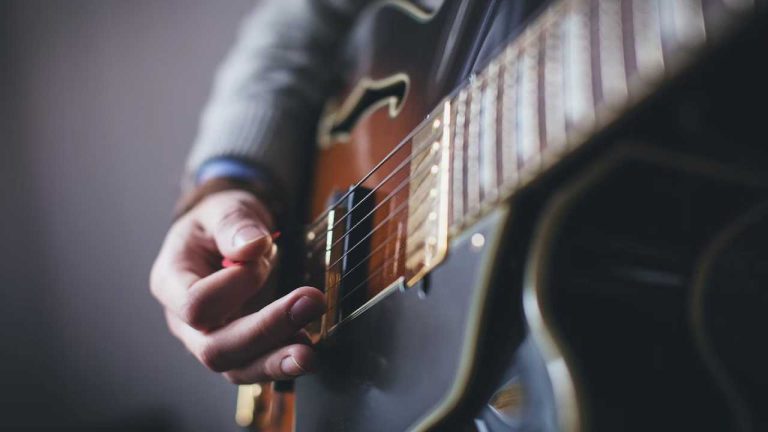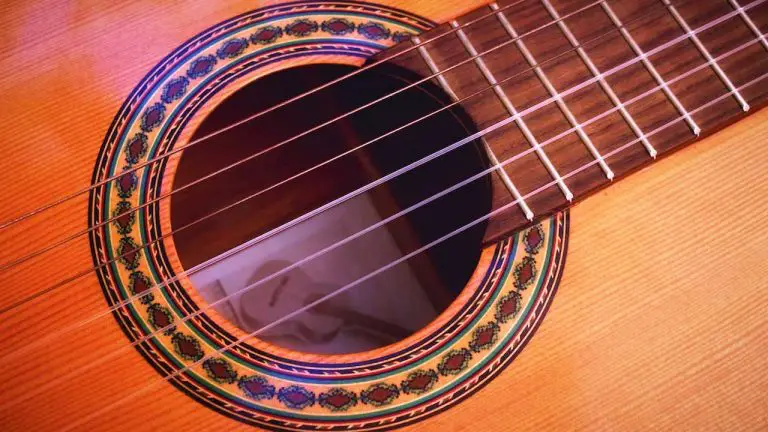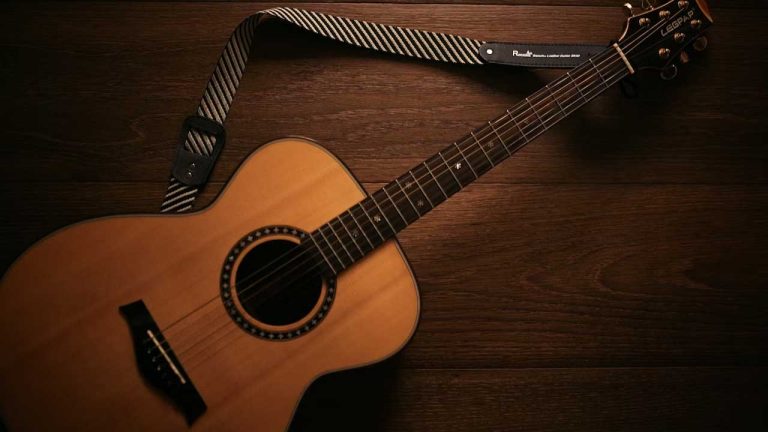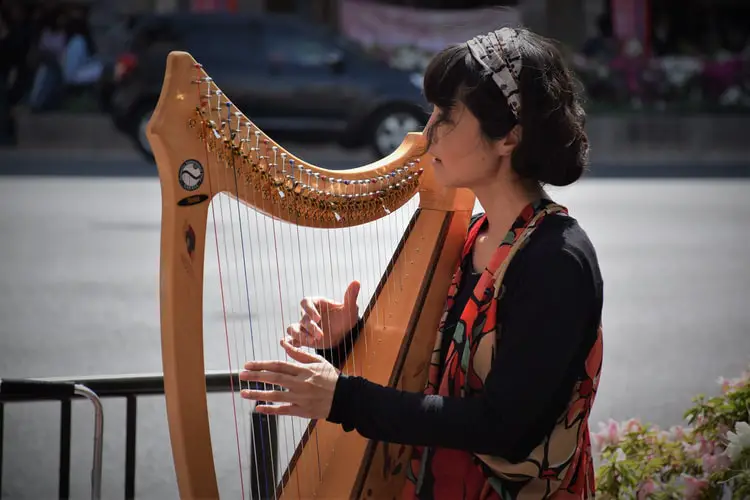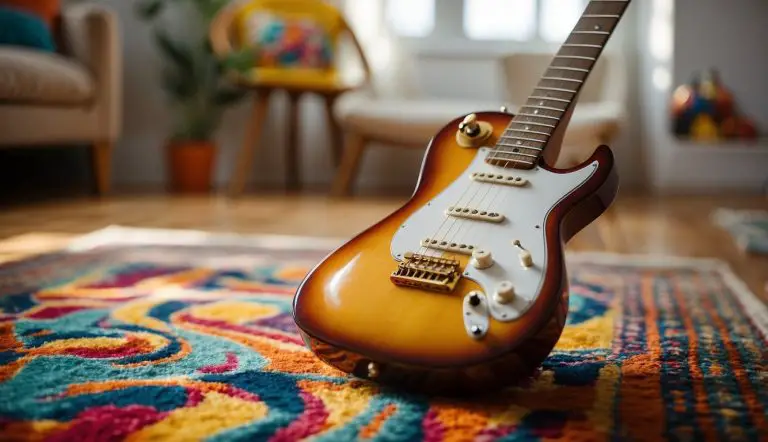Can Guitarists Play Harp? Transitioning from Strings to Strings
Folkstrings.com is reader-supported. When you buy through links on our site, we may earn a small commission.
As a guitarist, the prospect of playing the harp can be intriguing due to the stringed nature of both instruments. While these instruments share some common ground, such as the ability to produce melody and harmony, the techniques and approaches to playing them have distinct differences.
For example, guitar strings are often plucked using a plectrum or fingertips and can involve frequent note repetition. On the other hand, harpists use a unique technique that involves finger placement and movement to create the instrument’s characteristic sound.
Given the harp’s unique string arrangement and playing posture, guitarists embarking on learning the harp will need to adapt.
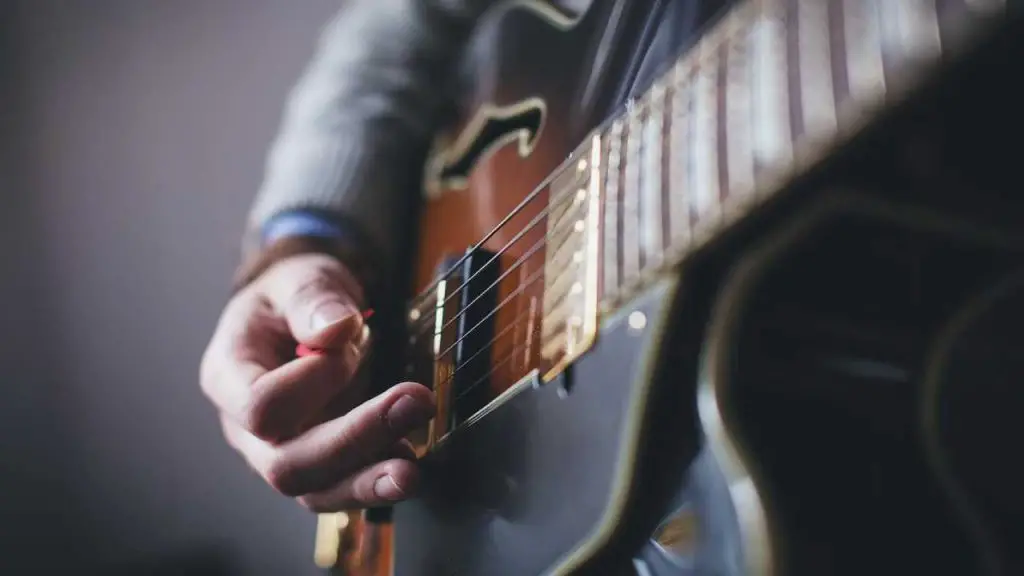
The transition from guitar to harp, while challenging, is facilitated by a musician’s fundamental understanding of music theory and string performance. Guitarists are accustomed to translating musical concepts across various fretboard positions, which can be an advantage when learning to navigate the harp’s array of strings.
Additionally, historical context and modern adaptations have shown that skills from one instrument can often be applied creatively to another.
As I explore what it entails for guitarists to take up the harp, incorporating new skills into an existing repertoire can open up a multitude of musical opportunities and expand a musician’s versatility.
Key Points
- Transitioning from guitar to harp presents a learning curve, but shared musical foundations can ease the process.
- Techniques specific to the harp must be mastered, even by skilled guitarists, to play effectively.
- Guitarists can enrich their musical expression by integrating harp skills into their repertoire.
Table of Contents
Similarities and Differences Between Harp and Guitar

In this section, I explore the unique characteristics and some overlapping aspects between harps and guitars, focusing on strings, playing techniques, and musical range and tuning. As a guitarist, you may find the transition to harp intriguing, and as a harpist, you might be curious about the guitar’s features.
String Comparison
Harp:
- Strings: Typically has 47 strings.
- Material: Often made of nylon, gut, or wire.
Guitar:
- Strings: Typically has 6 strings for acoustic and electric, but may vary in harp guitars.
- Material: Usually nylon for classical guitars, steel for acoustic, and nickel or stainless steel for electric.
Playing Techniques
For both instruments, the fundamental technique is to pluck the strings. However, the playing style and posture can vary greatly:
Harp:
- Playing requires the use of both hands on opposite sides of the string, and finger placement is crucial for clear sound production.
- Techniques include pres de la table (close to the soundboard) and finger articulations unique to the harp.
Guitar:
- Playing can involve strumming with a pick or plectrum, fingerpicking, or a combination of both.
- Classical and flamenco styles involve specific finger techniques on the fretboard, while electric guitarists might also use effects and amplification for diverse sounds.
Harp Guitarists:
- Utilize a combination of guitar and harp playing techniques, often requiring advanced knowledge of both instruments.
Musical Range and Tuning
The musical range and tuning systems illustrate a significant difference between the harp and guitar:
Harp:
- A vast range, covering over six octaves.
- Tuning is diatonic, with sharping levers or pedals to achieve chromaticism.
Guitar:
- A more limited range, typically around four octaves.
- Standard tuning is E-A-D-G-B-E, but it varies with musical genres and styles.
In both instruments, sound is produced by the vibrating string and resonated through the body or soundboard, with each having a unique timbre that shapes its musical expression.
Transitioning From Guitar to Harp
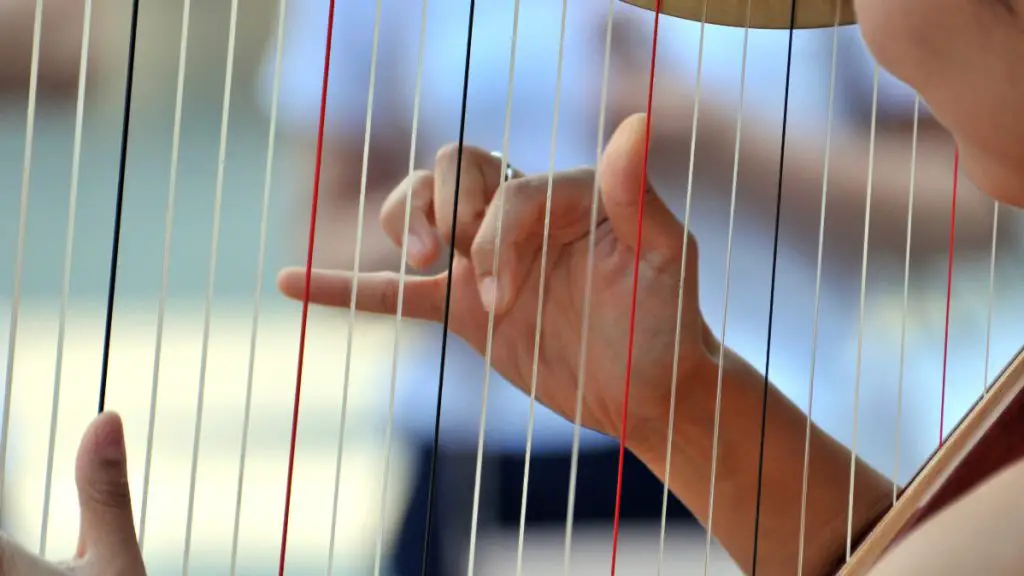
Transitioning from playing the guitar to the harp presents unique challenges and rewards. I’ll share insights into the learning curve, finding the right instruction, and selecting a harp that’s suitable for you.
Learning Curve and Practice
When I first approached the harp, I realized it requires a different hand position and technique. Unlike the guitar, where the strings are plucked laterally, the harp requires a vertical movement.
The transition involved understanding the lever or pedal system for changing notes, which is more complex than the frets on a guitar. The dexterity and muscular adaptation in my hands took consistent practice.
I found that setting aside regular practice time was crucial for my progress.
Finding a Teacher and Lessons
I sought out a qualified teacher who could guide me through the intricacies of the harp. Finding the right instructor involved looking for someone with experience in transitioning guitarists to harpists.
Lessons, whether in-person or online, were vital for my learning. They offered tailored exercises and direct feedback that helped improve my technique much faster than self-study could.
Choosing an Instrument
Deciding whether to buy or rent a harp was an important consideration for me. Renting initially helped me get a feel for the instrument without the commitment.
When I was ready to buy, I chose a harp that accommodated my level of expertise and the type of music I wanted to play. Researching the types of harps and trying them out was an enlightening experiment that informed my choice.
Historical and Modern Influences

When exploring the shared lineage between the guitar and the harp, it’s fascinating to uncover how historical developments and prominent musicians have shaped their interconnectivity. Let’s dive into the evolution of these instruments and some key figures who’ve mastered both.
The Evolution of Stringed Instruments
Stringed instruments have undergone significant transformations over the centuries. From the 19th century, the harp and guitar have seen technological and design refinements influencing their playability and roles in music.
The harp guitar, for instance, is a remarkable invention combining elements of both instruments, producing a rich and diverse sonic palette. Pioneers such as Chris Knutsen and later Gregg Miner played crucial roles in developing and popularizing these hybrids.
With strings that resonate sympathetically, harp guitars like those by Eduard Bayer and Pasquale Taraffo provided performers with expanded tonal capabilities.
Craftsmen like Luigi Mozzani contributed to the evolution with their innovative designs, leading to modern-day champions such as Michael Hedges and Andy McKee. They use the unique tonal qualities of hybrid instruments to create complex, resonant music.
Prominent Harp and Guitar Musicians
Several musicians stand out for their mastery of both the guitar and the harp.
Michael Hedges was known for his percussive style on the harp guitar, innovating techniques that have inspired countless guitarists.
Tom Shinness and James Kline are other notable harp guitarists who have contributed substantially to the art.
In exploring connections to other instruments, historically the harp evokes images of King David, while modern artists like Andreas Vollenweider, Joanna Newsom, and Benoit Meulle-Stef showcase its versatility.
Guitar virtuosos like Django Reinhardt, while not harpists, brought comparable innovations to guitar playing, influencing musicians across multiple domains.
In the hands of artists like Antoine Dufour and David Lindley, the musical conversation between these instruments continues, proving that guitarists can indeed find a voice on the harp, across genres and styles.
Incorporating Harp Skills into Guitar Repertoire
Integrating harp skills into my guitar playing opens up new possibilities for my musical expression, especially when adapting compositions originally meant for the harp or exploring various genres.
Adapting Guitar Music for Harp
When I transpose guitar music to the harp, I carefully consider the unique attributes of each instrument.
The guitar repertoire, including works by composers like Fernando Sor, offers a rich foundation that can translate well to the harp.
I look for pieces where the fluid arpeggios and resonant harmonies can shine on the strings of the harp. Here’s how I approach adapting:
- Composition Analysis: I analyze the composition’s structure, ensuring the melody can be preserved on the harp.
- Technique Adjustment: I adjust techniques such as plucking patterns to fit the harp’s playing style.
- Key Considerations: Some pieces might require changing the key to suit the harp’s range.
Exploring Genres with the Harp
Diving into various genres allows me to expand my horizons beyond the classical world. The harp can embody the intricate accompaniments commonly found in folk music. It also has a definitive presence in the rich tradition of Celtic music.
- Jazz: I explore jazz by focusing on the harp’s ability to provide both melody and accompaniment. I often experiment with the syncopated rhythms typical of the genre.
- Folk: I play folk tunes, embracing the harp’s ability to resonate with the third-string harmonies and open tunings that echo the traditional sound of folk music.
By incorporating harp skills into my guitar repertoire, I enrich my musical vocabulary and pay homage to the depth and diversity of both stringed instruments.
Frequently Asked Questions
I’ve collected some common questions about shifting from guitar to harp playing, which might help demystify the process for interested guitarists.
What skills do I need to transition from guitar to playing the harp?
My familiarity with string tension and hand coordination on the guitar aids in learning the harp. However, I need to develop pedal or lever operation skills for key changes. I also need to get comfortable with different hand positioning.
Are there any similarities between guitar and harp techniques?
I find that plucking strings and creating resonance on the guitar gives me a head start with similar techniques on the harp. The concept of finger-picking on both instruments is relatable, although the exact method varies.
How long does it typically take for a guitarist to learn to play the harp?
The time it takes me to learn the harp can depend on my dedication and practice routine. If I practice consistently, it’s possible to play basic pieces within a few months and more complex harp music in a couple of years.
What should guitarists be aware of when first attempting to play the harp?
I should be conscious of the harp’s unique posture and hand technique. Unlike the guitar, I’ll be using both hands independently to play the strings. I also need to adapt to the harp’s larger size and vertical orientation.
Do guitar tuning skills help when learning to tune a harp?
Yes, my understanding of tuning strings is helpful. However, I also need to learn how to use the harp’s tuning pins and how to maintain stability across a much larger number of strings.
Can playing the guitar provide a foundation for learning the harp?
Certainly, my musical knowledge and instrumental skills transfer to some extent.
Recognizing notes, musical timing, and expressive playing on the guitar give me a solid base to start learning the harp.
Author Profile
-
Daniel Johnstone is an English writer with a love for stringed instruments from around the world.
He shares his love for these instruments through his writing for folkstrings.com, a website dedicated to all things related to folk string music.
Daniel's passion for music started at a young age, and he has since become an accomplished musician, playing guitar, cavaco, and recently, the harp.
His dedication to learning and sharing his knowledge of stringed instruments is evident in his insightful and engaging blog posts. Whether you're a seasoned musician or a beginner, Daniel's writing is sure to inspire and entertain you.
When he's not playing music or writing, you can find Daniel exploring new instruments and seeking out new sounds to share with his readers.
Latest entries
 AutoharpApril 4, 2024What Is the Autoharp Made Of: Exploring Its Materials and Craftsmanship
AutoharpApril 4, 2024What Is the Autoharp Made Of: Exploring Its Materials and Craftsmanship AutoharpApril 4, 2024Is Autoharp Easy to Play? Unveiling the Truth for Beginners
AutoharpApril 4, 2024Is Autoharp Easy to Play? Unveiling the Truth for Beginners AutoharpApril 4, 2024What Is an Autoharp Worth? Your Guide to Pricing and Value
AutoharpApril 4, 2024What Is an Autoharp Worth? Your Guide to Pricing and Value AutoharpApril 4, 2024Are Autoharp and Zither the Same Thing? Unraveling String Instrument Myths
AutoharpApril 4, 2024Are Autoharp and Zither the Same Thing? Unraveling String Instrument Myths
Affiliates:
This post may contain affiliate links that at no additional cost to you, the site may earn a small commission. We only recommend products we would use ourselves and all opinions expressed on this site are our own.
Accuracy Advice:
While we strive to provide up-to-date and accurate information, the content in this article may not reflect the most current research or medical guidelines. We encourage readers to do further research and consult with professionals for more personalized advice.
Our Recommendations:
The products and services mentioned in any of our articles are recommended based on our independent research and personal experience. We are not sponsored by any company. We aim to suggest products and services we believe are of high quality and could be beneficial to our readers.

